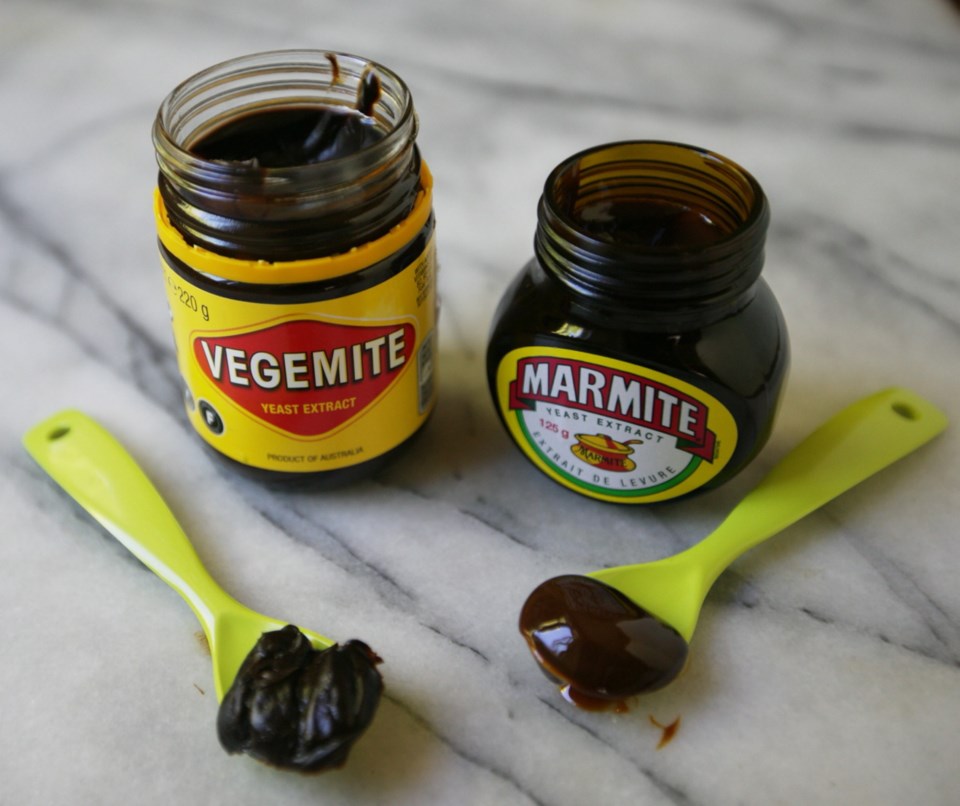Can you tell me the difference between Marmite and Vegemite?
Adam
Vegemite is a food product that is made and is popular in Australia.
Marmite is a food product that is made and is popular in England and other parts of the U.K.
Both are thick, very salty, dark — almost like engine oil — spreads/pastes made from the same key ingredient: yeast extract. Both are sold in Canada.
If you’ve ever lived in, travelled to or known people from Australia and England, you’ll be aware that there has been a long-running discussion as to whose product is the best.
According to the official Vegemite website, vegemite.com.au, that product first simmered to life in 1922. That’s when the original maker, Australia’s Fred Walker Company, began developing a spread from brewer’s yeast, a rich source of B vitamins.
It was first labelled “pure vegetable extract,” but that changed after a national competition was held asking Australian consumers to give it a new handle and Vegemite was the winner.
In 1923, it began being sold across Australia. Vegemite was pitched as being delicious on sandwiches and toast, and as a product that could improve the flavour of soups, stews and gravies.
But the maker of Vegemite had a problem. The product whose success it was trying to emulate, Marmite, already dominated the Australian market, and locals were reluctant to switch allegiances.
The Marmite website, marmite.co.uk, says this spread was invented in the 19th century by Justus Von Liebig, a German man who discovered that brewer’s yeast could be concentrated, bottled and eaten.
Marmite is a French term for a large covered earthenware pot. British-made Marmite was first supplied in earthenware pots, hence its name. It was marketed as being a delicious food extract invaluable for use in soups, sauces, stews, savouries and sandwiches.
That pitch must have worked, because according to a few sources, annual sales of Marmite, a brand now owned by giant company Unilever, top 25 million pounds (about $43 million).
Beyond the suggested uses listed, fans of Marmite will inform you that it’s good on or in almost anything.
For example, on her website, nigella.com, celebrity gourmand Nigella Lawson has a recipe for spaghetti with Marmite.
In the 1920s, Marmite began being sold in bulbous glass jars, as it still is, and that’s likely what many Australians would have been purchasing when Vegemite first hit the shelves.
As noted, Vegemite was not popular in Australia at first. It was renamed Parwill and then called Vegemite again.
After 14 years of perseverance by the Fred Walker Company, though, Australians finally began to embrace it and now do so big- time. Today, more than 22 million jars of Vegemite are sold every year.
As noted, both Vegemite and Marmite are thick, very salty, dark spreads/pastes. I — and many others — would say both are also an acquired taste.
If you grew up eating and liking them, like peanut butter for many North Americans, it’s a normal, everyday food. Others, though, me included, wonder why you would ever eat them, despite the high vitamin-B content and other suggested health benefits. Both have very intense tastes, to say the least.
That said, to finally answer Adam’s question, beyond where it’s made, what makes Vegemite taste and smell different than Marmite is differences in flavourings.
The label for Marmite says it also contains dehydrated carrots and onions, and spice extract. Vegemite’s label does not list any of those items and contains ingredients not found on Marmite’s label, such as colour, flavours, niacin, thiamine, riboflavin and folate.
I must note that a company in New Zealand called Sanitarium Health and Wellbeing also makes a brand of Marmite.
It uses a different recipe than the original Marmite made in the U.K., and has its own army of fans saying it’s the best among these products.
Hamburger relish followup
Last Sunday, I wrote about Bick’s red hamburger relish no longer being available for retail sale in Canada.
In that story, at the request of two readers who were missing it, I published a recipe for homemade hamburger relish.
I also suggested that they should try the relish being made locally by Maison Preserves Co., which sells its products at Victoria’s Moss Street Market on Saturdays.
Shortly after that column was published, several readers let me know that Canadian-owned company Whyte’s (whytes.ca) also makes and sells a brand of this type of relish, called Strub’s Hamburger Relish.
Those readers said they enjoyed Strub’s, which is available at places such Save-on-Foods and Country Grocer.
Eric Akis is the author of eight cookbooks. His latest is The Great Rotisserie Chicken Cookbook (Appetite by Random House). His columns appear in the Life section Wednesday and Sunday.



